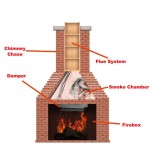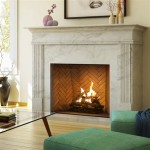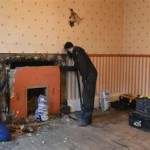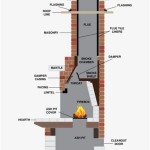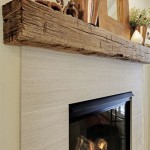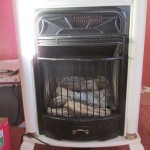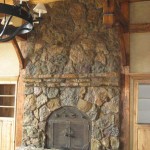Parts of a Fireplace Chimney: A Comprehensive Guide
The fireplace chimney is a critical component of any home heating system that utilizes a wood-burning fireplace. Its primary function is to safely vent combustion gases, including smoke, carbon monoxide, and other byproducts, away from the living space and into the atmosphere. A properly constructed and maintained chimney is essential for preventing fire hazards, ensuring adequate ventilation, and complying with building codes. This article provides a detailed overview of the various parts of a fireplace chimney, explaining their individual functions and their collective contribution to the overall performance of the system.
The Chimney Foundation
The foundation is the base upon which the entire chimney structure rests. It is typically made of reinforced concrete and extends below the frost line to prevent shifting and cracking due to ground movement. The foundation must be of adequate size and strength to support the considerable weight of the chimney, especially in multi-story homes or regions prone to seismic activity. Proper engineering is crucial in designing the foundation to ensure long-term stability and prevent structural failures that could compromise the integrity of the entire chimney system. Factors such as soil composition and local building codes are carefully considered when determining the dimensions and construction methods of the foundation.
The foundation should be isolated from the main house foundation to allow for differential settling. This separation prevents stresses from being transferred between the two structures, reducing the risk of cracks and structural damage. A small gap, often filled with a flexible sealant, is maintained between the chimney foundation and the house foundation to accommodate independent movement.
The Chimney Chase
In many modern homes, particularly those with prefabricated fireplaces, the chimney is often encased in a decorative structure called a chimney chase. The chase is essentially a box that surrounds the chimney flue and provides a finished appearance. It is typically constructed from wood framing and covered with siding, brick veneer, or other decorative materials to match the architectural style of the house.
The chimney chase serves both aesthetic and functional purposes. Aesthetically, it provides a visually appealing enclosure for the chimney, blending it seamlessly with the overall design of the home. Functionally, the chase offers protection from the elements, preventing moisture and wind from entering the chimney structure. It may also house insulation to improve the energy efficiency of the fireplace system by reducing heat loss through the chimney walls.
However, improperly constructed chimney chases can be a significant source of problems. If the chase is not adequately ventilated, moisture can become trapped inside, leading to wood rot, mold growth, and deterioration of the chimney structure. It is crucial to ensure that the chase has proper ventilation openings to allow air to circulate and prevent moisture buildup. Additionally, the chase should be constructed with fire-resistant materials to minimize the risk of fire spreading from the chimney to the surrounding structure. Regular inspections of the chimney chase are necessary to identify and address any potential problems before they escalate into more serious issues.
The Chimney Flue
The flue is the inner lining of the chimney, acting as a conduit for the exhaust gases produced by the fireplace. It is a critical component responsible for safely channeling smoke and combustion byproducts out of the house and into the atmosphere. The flue is typically constructed from clay tiles, metal, or concrete, each material offering varying degrees of heat resistance and durability. The choice of flue material depends on the type of fuel burned in the fireplace and local building codes.
Clay tile flues are a traditional and relatively inexpensive option, but they are susceptible to cracking and deterioration over time, especially when exposed to extreme temperature fluctuations or corrosive gases. Metal flues, commonly made of stainless steel, offer superior heat resistance and durability compared to clay tiles. They are often used when relining damaged chimneys or when installing new fireplaces that burn fuels such as gas or propane, which can produce corrosive byproducts. Concrete flues provide a balance of durability and affordability and are commonly used in masonry chimneys.
Regardless of the material used, the flue must be properly sized to accommodate the volume of exhaust gases produced by the fireplace. An undersized flue can restrict airflow, leading to smoke backdrafting into the house. An oversized flue can allow the gases to cool too quickly, resulting in condensation and the formation of creosote, a flammable substance that can accumulate on the flue walls and increase the risk of chimney fires. Regular cleaning and inspection of the flue are essential to maintain its proper function and prevent potential hazards.
The Smoke Chamber
The smoke chamber is a funnel-shaped area located immediately above the firebox. Its purpose is to collect the smoke rising from the fire and direct it into the chimney flue. The shape of the smoke chamber is designed to improve the draft efficiency of the chimney, creating a smooth transition for the smoke as it enters the flue. A properly constructed smoke chamber minimizes turbulence and reduces the likelihood of smoke spilling back into the room.
The interior surfaces of the smoke chamber should be smooth and free of obstructions to ensure efficient airflow. Any rough surfaces or protrusions can create turbulence and impede the flow of smoke. The smoke chamber is typically constructed from masonry, with a parged or plastered finish to create a smooth, airtight seal. Cracks or gaps in the smoke chamber can allow smoke to escape into the house, creating a fire hazard and reducing the efficiency of the fireplace.
The Smoke Shelf
The smoke shelf is a small, ledge-like projection located at the base of the smoke chamber, just above the damper. Its primary function is to prevent downdrafts from entering the firebox and disrupting the fire. Downdrafts are caused by wind blowing down the chimney, which can push smoke back into the room. The smoke shelf creates a small, protected area where the downdraft can dissipate, preventing it from interfering with the upward flow of smoke from the fire.
The smoke shelf also serves as a collection point for debris that falls down the chimney, such as leaves, twigs, and small animals. This debris can obstruct the airflow in the chimney and increase the risk of chimney fires. Regular cleaning of the smoke shelf is necessary to remove any accumulated debris and maintain proper chimney function. The smoke shelf is typically constructed from masonry and should be carefully designed and installed to ensure its effectiveness in preventing downdrafts and collecting debris.
The Damper
The damper is a movable plate or door located in the chimney, typically just above the firebox or at the base of the smoke chamber. Its purpose is to control the airflow through the chimney. When the fireplace is not in use, the damper should be closed to prevent heat from escaping up the chimney and to keep drafts from entering the house. When the fireplace is in use, the damper should be fully open to allow smoke and exhaust gases to vent properly.
There are several types of dampers available, including throat dampers, top-mounted dampers, and energy-efficient dampers. Throat dampers are the most common type and are located just above the firebox. They are relatively inexpensive but can be prone to rusting and warping over time, leading to air leaks. Top-mounted dampers are installed at the top of the chimney and provide a tighter seal than throat dampers, reducing heat loss and preventing moisture from entering the chimney. Energy-efficient dampers are designed to provide an even tighter seal and often incorporate features such as insulation to further reduce heat loss.
A malfunctioning damper can significantly affect the efficiency and safety of the fireplace. A damper that is stuck open can allow heat to escape up the chimney, increasing energy costs. A damper that is stuck closed can prevent smoke from venting properly, leading to smoke backdrafting into the house. Regular inspection and maintenance of the damper are essential to ensure its proper function and prevent potential problems.
The Chimney Cap
The chimney cap is a protective covering installed at the top of the chimney. Its primary function is to prevent rain, snow, leaves, and animals from entering the chimney flue. A chimney cap can also help to prevent downdrafts by deflecting wind away from the chimney opening. In addition, some chimney caps include a spark arrestor, which is a mesh screen that prevents sparks from escaping the chimney and potentially igniting nearby vegetation or combustible materials.
Chimney caps are available in a variety of materials, including stainless steel, copper, and galvanized steel. Stainless steel caps are the most durable and resistant to corrosion. Copper caps offer an attractive aesthetic and can add value to the home. Galvanized steel caps are a more affordable option but are less durable than stainless steel or copper.
A properly installed chimney cap is essential for protecting the chimney from the elements and preventing potential hazards. Without a chimney cap, rain and snow can enter the chimney, leading to moisture buildup and corrosion of the flue liner. Leaves and other debris can accumulate in the chimney, obstructing the airflow and increasing the risk of chimney fires. Animals such as birds, squirrels, and raccoons can build nests in the chimney, blocking the flue and creating a fire hazard. Regular inspection and maintenance of the chimney cap are necessary to ensure its proper function and prevent potential problems.
The Crown
The chimney crown is the top, sloping surface of the chimney, typically made of concrete or masonry. Its purpose is to protect the chimney from water damage. The crown slopes outwards, directing water away from the flue and the chimney walls. A properly constructed chimney crown prevents water from penetrating the chimney structure, which can lead to cracking, spalling, and deterioration of the masonry.
The chimney crown should extend beyond the flue liner on all sides to provide adequate protection. It should also be sealed with a waterproof sealant to prevent water from penetrating the concrete or masonry. Cracks in the chimney crown can allow water to enter the chimney, leading to serious structural damage. Regular inspection and maintenance of the chimney crown are essential to prevent water damage and prolong the life of the chimney.
The Chase Top
For chimneys with a chimney chase, the chase top is the covering over the top of the chase structure. This top provides weather protection for the chimney and the structure of the chase itself. The chase top is commonly made of metal, like aluminum or steel, and it is formed to slope away from the flue, guiding rainwater away from the inner workings of the chimney.
Proper installation and maintenance of the chase top are vital for preventing water damage. If the chase top is damaged or improperly sealed, water could enter the chase, potentially leading to mold growth, wood rot, and structural damage. Regular inspections of the chase top are beneficial for locating and repairing any issues promptly.

Chimney Parts And How They Work 2024 All Pro Service

The Complete Anatomy Of A Chimney Chimcare

Understanding The Anatomy Of A Fireplace Madewell Masonry

Parts Of A Fireplace Chimney Explained With Diagrams And Real S

The Diffe Parts Of A Chimney Fireplace Guide 2024

Parts Of A Fireplace Explained With Diagram Homenish Chimney Cleaning Facing

Parts Of A Chimney All American

Chimney System Anatomy Crofton Md Cleansweepaa Com

Chimney Inspection Ingram S Sweepers

Learning About Masonry Fireplaces Parts Of A Fireplace

